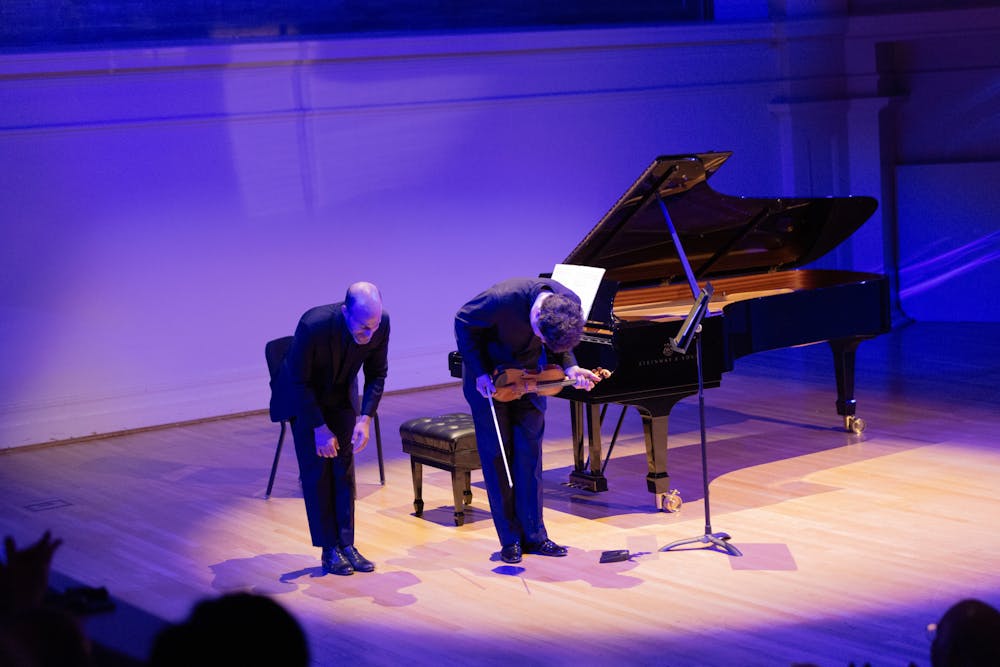For classical enthusiasts across Charlottesville, few events were as eagerly anticipated as the performance of chamber music duo Augustin Hadelich and Orion Weiss — and rightfully so. Presenting the introductory recital of the Tuesday Evening Concert Series, the pair serenaded listeners with an array of classical melodies, elegant sonatas and contemporary showpieces that left the audience fulfilled and warmed on an otherwise chilly Tuesday evening.
One of the world’s preeminent violinists, Augustin Hadelich was named “Instrumentalist of the Year” by Musical America and won a Grammy Award for his rendition of Henry Dutilleux’s Violin Concerto. Orion Weiss is an equally stellar musician — he has been named “Young Artist of the Year” by the Classical Recording Foundation and performs with numerous national and international ensembles.
As Hadelich and Weiss — clad in sleek, black button-ups — emerged onto the Old Cabell stage and took their first bow, concertgoers found themselves in hushed awe and anticipation of the performance.
The artistic pair introduced the evening with Beethoven’s Sonata No. 10 in G Major for violin and piano. Notable for the understated, delicate passages in its early movements, the piece enabled the musical sensitivities of Hadelich and Weiss to shine.
From the sonata’s opening notes, the duo’s commitment to creating a clear but subdued sound was evident. Hadelich’s body language was especially compelling — the musician would lean forward throughout as if to cradle his violin and the notes emerging from it.
The sonata also included sections of double stops — pairs of two notes played simultaneously — that offered the audience an initial taste for Hadelich’s technical capabilities. After a stately conclusion to the piece, the duo rose to take a bow before momentarily exiting the stage.
Hadelich returned with a microphone in hand to introduce the next piece. “Road Movies,” by American composer John Adams, Hadelich said, was a three-movement work inspired by driving. He joked that the first movement was filled with complex rhythmic “potholes” and thus reminded him of Weiss’s home state of New Jersey, scoring a laugh from the audience.
The violinist likened the second movement to “traffic on a summer day” and compared the third movement to speeding along a highway — perhaps one from Germany, his home country — prompting a second round of laughter from the audience.
The piece opened with a syncopated, contemporary first movement — the light, airy groove combined with open intervals generated a distinctly American sound. In the second, Hadelich’s use of slow glissando, or sliding, combined with the movement’s atonal quality created a drowsy, unfocused feel not unlike Hadelich’s reference to summer traffic.
“Road Movies” concluded with a rowdy movement utilizing the syncopation present in the opening of the piece. As Hadelich and Weiss sped towards its final bars, the most striking element of their performance was how much they were enjoying the composition — the two couldn’t help but smile at and bounce as they accelerated to the end of their musical road trip.
Following an intermission, Hadelich dove further into non-traditional repertoire with Daniel Bernard Roumain’s “Filter” for solo violin — a piece that, according to Hadelich, was inspired by the guitarist Jimi Hendrix. The work was wildly virtuosic, defined by passages of piercing notes, chords and speeding rhythms. Hadelich’s impassioned movements and ferocious technique led to several broken bow hairs — Hadelich was, for lack of a better term, rocking out.
The duo then returned to a more traditional work with Prokofiev’s Sonata No. 1 in F Minor for Violin and Piano, a piece that put Weiss’s articulation on full display. As Hadelich climbed up and down the violin with fast runs, the pianist accompanied with light, repeated patterns, resulting in an arresting contrast in sound between the instruments. In a later movement, his precision shined as Weiss carefully mirrored the phrases in the violin part.
The enchanting pair brought the concert to a close with Amy Beach’s “Romance” for violin and piano. With this work, Hadelich’s vibrato allowed sustained notes to glow, and his bow control ensured that every phrase connected smoothly with the next. But perhaps Hadelich’s greatest musical strength — his tone — excelled in this piece. Each note resonated with fullness and warmth, with clarity and purpose.
The selection of repertoire by Hadelich and Weiss speaks to their distinctiveness as artists. Despite being classical musicians, two of their five performances were contemporary. In programming these pieces, though, the duo managed to brilliantly showcase their technical and emotional maturity, and most importantly, their musical inventiveness.
After an extended, well-deserved standing ovation from the audience, Hadelich delivered a solo encore. Complete with flashy double stops and virtuosic left hand plucking, the piece sent the audience off with a bombastic end to a diverse and compelling evening of music.







